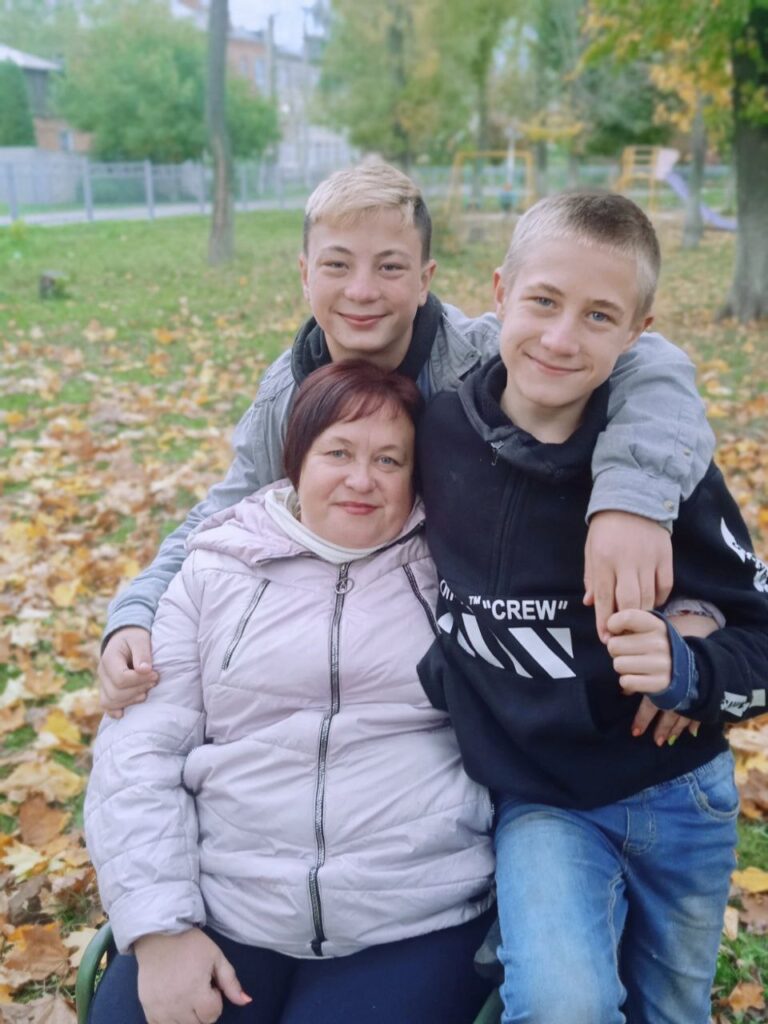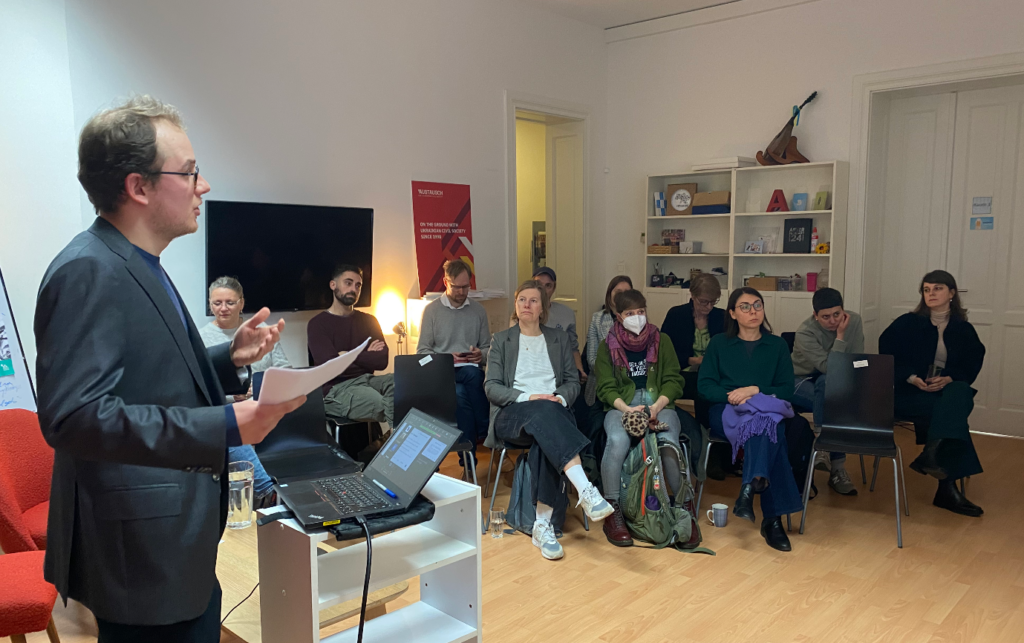“That Evacuation was an Absolute Nightmare”
The Story of a Disabled Displaced Woman Who Escaped Occupation
More than 11 million Ukrainian men and women left their homes because of Russia’s full-scale invasion of Ukraine. 4.2 million went abroad, and over 7 million became internally displaced persons, according to the International Organization for Migration. Amid a full-scale war, Ukraine’s social welfare system faced the urgent task of swiftly evacuating and sheltering millions. Although local authorities and organizations dealt with similar situations in 2014 during Russia’s annexation of Crimea and occupation of parts of Donetsk and Luhansk oblasts, the current challenge is far greater. Since February 24, 2022, the number of internally displaced persons has more than quadrupled from previous years. Per the Ministry of Reintegration, 60% of IDPs are women, 25% are children, 25% are pensioners, and almost 200,000 are people with disabilities.
On February 24, the first day of the invasion, Russian troops entered Kherson Oblast, occupying much of the territory including the city of Kherson. Facing this harsh new reality under occupation were Liubov, her two sons Mark and Matvii, ages 11 and 13.
“We lived in the Kherson region. I have a small house there that I bought long ago when my second child was born. We made repairs with our own hands. When war came, it was just my kids and I at home. I remember clearly – at 6 AM on that day, the Russian occupation forces had already reached us. My kids and I lived under occupation for 3 months, planning to relocate every single day.”
Liubov’s sister waited in Ukraine-controlled territory, renting a house in Pokotylivka village near Kharkiv. As soon as an evacuation opportunity appeared, Liubov rented a car and departed for Kharkiv.
“That evacuation was an absolute nightmare. No one helped us; there were no humanitarian corridors, so we risked everything to evacuate ourselves. The invaders scrutinized everyone; barely anyone was released except children and women. Even then, you had to have a disability certificate or be visibly pregnant. Everyone else had to return home to live under occupation. As a disabled person, I was released with my kids.”
For nearly a year, Liubov resided in rented accommodations, personally covering expenses. At times she paid 7,000UAH just for housing. Eventually it became unaffordable, prompting her decision to seek assistance.
“I searched cheaper options daily but lacked funds. I subscribed on Facebook to Iryna Vereshchuk* and sent her a direct message describing my situation and inability to afford further rental housing. She replied that they could help us.”
*Iryna Vereshchuk is Ukraine’s First Deputy Prime Minister and Minister of Reintegration of Temporarily Occupied Territories.
Liubov and her children were then placed in the Kharkiv National University of Radio Electronics men’s dormitory, now used collectively to house internally displaced persons (IDPs) – locally termed an “IDP shelter.” These temporary shelters are stopgap solutions until more permanent housing becomes available. Local authorities and organizations use all possible options for housing, f.e. dormitories, schools, sanatoriums, and even restaurants, with utilities financed through local budgets. Public and nonprofit groups provide food and essentials.
“We were given two dormitory rooms – one for me, one for my sons. We share the kitchen. With few residents here, it’s typically just myself and one other person cooking (laughs). Our lodging is free, plus we each receive 3,000 UAH as IDP. Between that and my pension, I can afford groceries. The only issue now is procuring internet access and computers for the boys’ online schooling, which I cannot currently afford.”
Modular towns are another housing solution the Ukrainian government has offered IDPs since 2014, mainly donor-funded. Key benefits are swift modular home installation and portability between regions – important for those displaced from destroyed housing while repairs occur so they can remain employed nearby.
However, none of these options properly accommodate people with disabilities. Modular facilities lack accessibility features and information. Modular housing is not a construction object, so the developer is not obliged to build modular houses in compliance with the minimum of accessibility requirements, as this is not provided for by law. Considering the outdated approach to accessibility for existing Soviet-era dormitories, sanatoriums, and schools where IDPs now shelter, just entering these buildings is impossible for Liubov without assistance.
“Our rooms are on the first floor, which is an advantage. There is a ramp but I can only use it to exit. When returning, I have to call my son to help me.”
Per the latest data, Russia’s full-scale invasion of Ukraine has damaged or destroyed 2.5 million homes, excluding occupied territories. Over nine years of conflict, housing needs assessments for IDPs overlooked needs for people with disabilities and other marginalized groups. Thus, local governments can only triage their critical needs. For comprehensive post-war rebuilding incorporating accessibility to modern European standards, Ukraine requires expanded national programming – already underway via the Recovery of Ukraine Plan, targeting housing and infrastructure.
The Ministry of Reintegration, with Council of Europe support, has in the meantime also adopted a State Policy Strategy on Internal Displacement – assisting IDPs to find jobs, place children in kindergartens and schools, make connections, and integrate into their new communities. Largely owing to dedicated civic organizations and donor funding, specialized IDP service hubs now offer career guidance, vocational courses, psychosocial rehabilitation, and more.
I’m eager to work. Before the war I volunteered at my local church, supporting homeless children. However, building connections at new place takes time and adjustment.
The Fight for Right NGO advocates for rights of disabled Ukrainians. They are implementing the “Barrier-Free Safety for People with Disabilities” project, executed by the Austausch e.V. organization alongside Eastern Partnership countries, funded by the German Federal Foreign Office. The project aids disabled citizens staying in Ukraine amid war or displaced abroad due to Russia’s invasion.
Through firsthand stories like Liubov’s, Fight for Right spotlights the difficulties of Ukraine’s disabled population impacted by conflict – evacuation trauma, housing barriers, and harsh new realities for those relocated internally.
Liubov Braha, profiled here, receives state disability benefits and requires a wheelchair. Prior to Russia’s full-scale invasion, she resided in Kherson with two adolescent sons, but the family has since evacuated north to Kharkiv after three gruelling months under Russian occupation. We discussed her escape, challenges securing accessible lodging, and current discounted dormitory shelter with state IDP assistance.
This material was prepared for the “Barrier-Free Safety for People with Disabilities” project, which is part of the INKuLtur Programme funded by the German Federal Foreign Office.




